



Global heating is a cold, hard fact. There’s still time to avoid the worst of the climate catastrophe. But leaders must act – now.
António Guterres, United Nations Secretary-General
According to World Meteorological Data, the planet’s average temperature in 2024 was 1.6 degrees Celsius higher than in the 1850-1900 pre-industrial period. The last 10 years are the 10 hottest years on record1.
With five targets and eight indicators, SDG 13 is considered one of the biggest stories of our times due to the rapidly changing climate-related impact. Hence, it would not be an exaggeration to say that climate action is the most critical action we can take for the sake of current and future generations.
At Shiv Nadar University, two of the four priority research areas are Energy and Environment. Firmly committed to the global framework of Sustainable Development Goals, this report highlights our key action areas reflected in our teaching, research, partnerships, and institutional practices, including reducing carbon footprint, minimizing wastage, increasing the use of alternative energy, water conservation, organic food practices, and many more.
TEACHING AND LEARNING
The university offers several courses on climate and its impact at the local and global levels. Department of Sociology offers a course on the Anthropology of
climate change (SOC305), which introduces students to the new but rich subdiscipline of the anthropology of climate change by questioning how humans have become the center of public debate and international policy, precisely as it remains unclear what the future world affected by climate change holds. The Department of Civil Engineering offers a graduate course on Climate and Climate Change (CED660). Many compulsory courses are offered regularly to undergraduate students, such as Atmospheric Aerosols & Climate (CCC 405), Climate Change and Media (CCC 721), Climate Change and Conflict (CCC 719), Environmental Studies (CCC704), Introduction to Climate Change (CCC705), and Environmental Impact Assessment (CCC 406).
Master’s Program in Global Urban
Sociology in partnership with the School of Oriental and African Studies (SOAS), London
Urbanization is of extraordinary significance for the regions in which SOAS and Shiv Nadar University academics focus, and globally, it is a topic that brings together many of the most pressing concerns of our times, from climate, sustainability, to mental health, pollution, illness, and issues of governance and policy.
https://www.reuters.com/business/environment/2024-was-first-year-above-15c-global-warming-scientists-say-202501-10/?utm_source
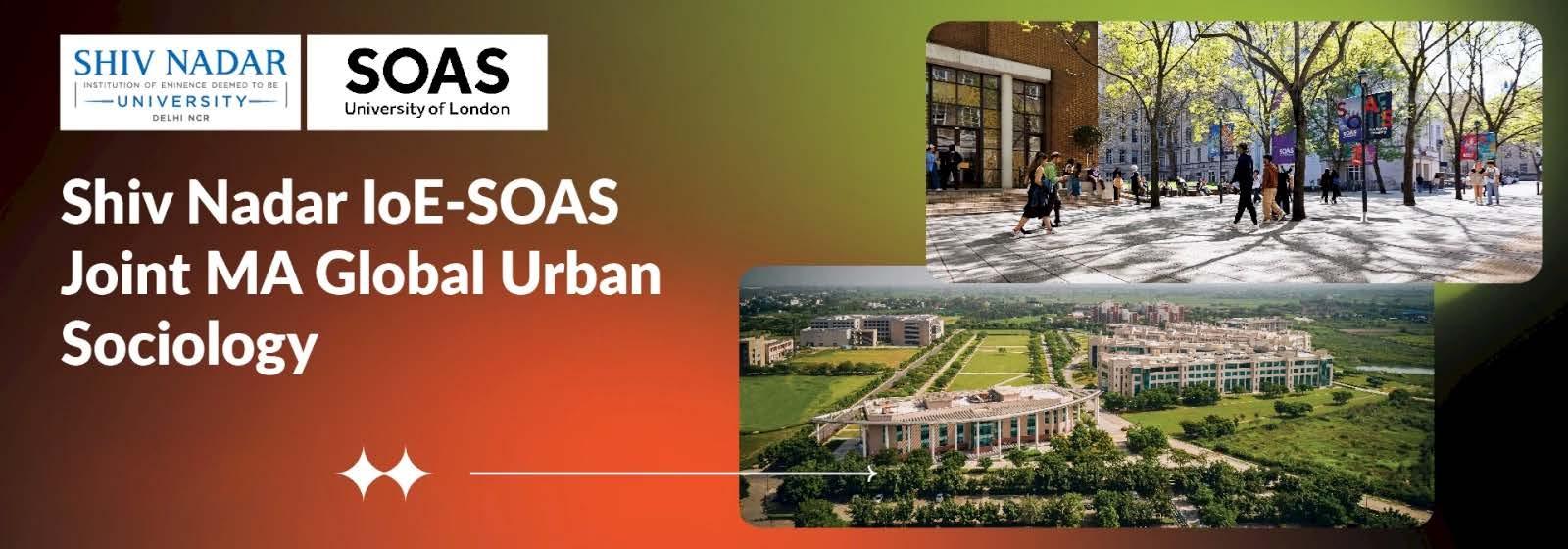
The joint Master of Arts program in Global Urban Sociology provides a unique opportunity for students to grasp the broad global historical/political/cultural canvas against which sociology is studied and how sociology may be useful for thinking about urban global futures. It offers students an option to study current global issues around urbanism with reference to specific case studies drawn from different cities around the world. It also provides an opportunity for students to develop their ability to construct critical evaluations of the applicability of sociological frameworks to ‘real-world’ problems, including in their own research project on the ‘Dissertation’ module.
STUDENT STORIES
Carbon Markets affect marginalized communities
Adithya Santhosh Kumar, a recent alumnus, published a piece on how carbon markets affect marginalized communities and turn indigenous farming practices into corporate profit, leaving communities empty-handed.

Exemplifying the university’s interdisciplinary aspirations, Adithya recently graduated with a major in Mechanical Engineering, with a minor in International Relations, and has a keen interest in sustainability.
Social Sector Internship - Student Projects
Social Sector Internship is an eight-week rigorous and mandatory internship on real-life projects that provides our undergraduate students in the School of Management and Entrepreneurship with the context, empathy, and expertise to make decisions, keeping in mind the triple bottom line involving people, planet, and profit, irrespective of the professional or entrepreneurial roles they assume in the future.
This on-site internship immersion in rural and nonurban ecosystems allows students to work with the local indigenous communities to ameliorate social enterprise challenges or create growth models for the social sector, thus, generating new forms of knowledge where disciplinary barriers are dissolved; the divides between the scholar and the practitioner, the thinker and the doer, are overcome, and concrete societal benefits accompany the academic benefits of research.
Some examples of these projects in SDG 13 are:
Sanidhya Dariwal worked with ESROEnvironment and Social Research Organization on the engagement of school youth in climate justice. The project included collecting pre-data from the school youth, their families, teachers, communities, religious leaders, and the review of research papers/scriptures/websites. The project also involved designing a curriculum to be implemented in schools that the ESRO-NGO will use during their awareness efforts. Various world

religions have cited and advocated for climate justice through environmental conservation/ preservation. The main intent of the project was to fill the gap by integrating these concepts into environmental education.
Chockalingam R. worked with Shri. A.M.M. Murugappa Chettiar Research Centre (MCRC), on assessing biochar’s impact on paddy crop yield, fertilizer reduction, climate change, and cost-benefit analysis for farmers. The project provided valuable insights into the economic benefits of biochar usage, such as reducing fertilizer costs, improving soil health, and environmental conditions, as well as how biochar directly contributes to mitigating climate change.
Alumni driving impactful change in climate adaptation and resilience across the Global South
Anirudh Kishore, alumnus, class of 2018 & 2022, with a Bachelor’s in Civil Engineering and a Master’s in Water Science and Policy, from Shiv Nadar University, is working as a climate consultant at Dalberg Advisors, driving impactful change in climate adaptation and resilience across the Global South. With over five years of experience in the climatewater sector, he collaborates with communities, governments, and global organizations to create sustainable, climate-resilient pathways. His expertise in water governance, urban water security, and nature-based solutions is helping to shape a more resilient and equitable future, advancing climate solutions, and championing environmental sustainability.
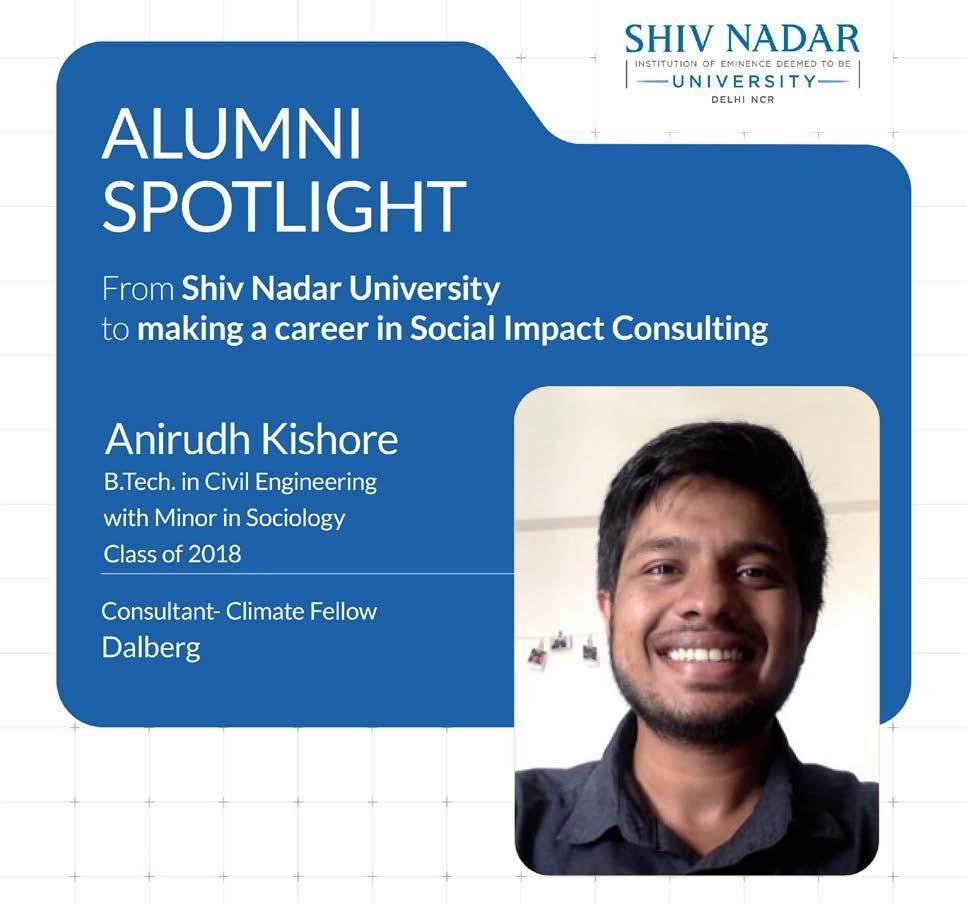
RESEARCH
Shiv Nadar University Pioneers Eco-Friendly Polymers For Carbon Neutrality
Dr. Bimlesh Lochab, Professor, Department of Chemistry, and Dr. Sangeeta Sahu, Post Doctoral scholar at Shiv Nadar University, have developed sustainable polymers from waste sulfur and cardanol, offering a promising solution to plastic pollution and carbon emissions. This is an innovative solution to the global challenge of carbon neutrality. Their research has been published in the ACS Sustainable Chemistry & Engineering journal, introducing a new class of waste-derived polymers, utilizing naturally abundant feedstocks, and achieving attractive features.

NERL
develops advanced nanomaterials for sustainable energy storage and conversion, accelerating progress toward SDG 7 and strengthening climate action under SDG 13
Dr. Binson Babu, Assistant Professor, leads research at the Nanoscience and Energy Research Lab (NERL), Department of Physics, School of Natural Sciences. Along with his group, Dr. Babu is spearheading cutting-edge interdisciplinary research to accelerate the global green energy transition, directly contributing to SDG 7: Affordable and Clean Energy and SDG 13: Climate Action.
The research focuses on designing novel nanomaterials and advanced electrolytes for sustainable energy storage systems, including
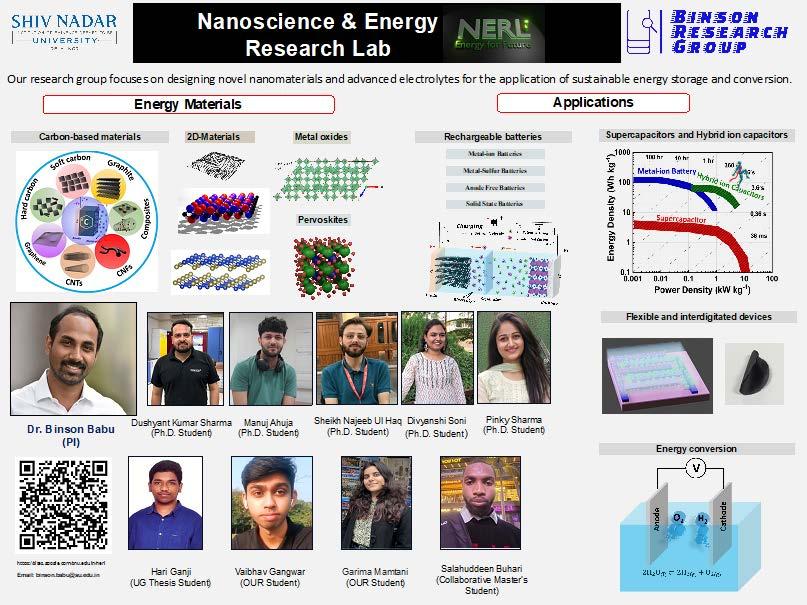
rechargeable batteries, supercapacitors, and hybridion capacitors, enabling the integration of renewable energy into power grids. The group also works to advance energy conversion technologies such as electrochemical water splitting to produce clean hydrogen, offering low-carbon alternatives to fossil fuels.
By developing next-generation energy materials, NERL is advancing research to support the shift towards a low-carbon economy, helping mitigate climate change while ensuring access to clean, reliable, and sustainable energy solutions.
Bioenergy Production via Thermochemical Conversion of Waste Biomass
Dr. Sanjeev Yadav, Associate Professor, Department of Chemical Engineering, and his group are working on thermochemical conversion of waste biomass into different forms of bioenergy through an experimental and simulation study.
Improper waste biomass management leads to many environmental concerns, like greenhouse gas emissions, soil degradation, and water contamination. The research group offers an alternative to waste management by using thermochemical conversion methods to generate energy. This year’s experimental studies involved the conduct of steam gasification and fast pyrolysis of mixed food waste. Steam gasification was conducted in the presence of a novel catalyst, which significantly enhanced hydrogen production. It also helped reduce the tar generation effectively from the steam gasification of mixed food waste. The second experimental work studied the effect of hot vapor residence time (HVRT) on bio-oil production via fast pyrolysis of mixed food waste. The third study was a modelling and simulation work done using Aspen Plus for groundnut shell gasification using a bubbling fluidized bed gasifier. The developed model is in agreement in terms of composition, yield, and higher heating value of the syngas generated experimentally.

Pectin biopolymer to develop composite thin films for use as biodegradable wraps for vegetables and fruits.
Dr. Yamini Sudha, Associate Professor, Department of Chemical Engineering, has used pectin biopolymer to develop composite thin films for use as biodegradable wraps for vegetables and fruits. Her research aims to significantly boost the shelf life of produce and reduce hazards to the human body and nature.
The biodegradable wraps are made by extracting pectin from bananas, oranges, and sweet lime. They are a natural, edible coating that can replace synthetic wax, which gives fruits gloss and longevity. Along with her research group, Dr. Shudha has successfully produced small films with improved
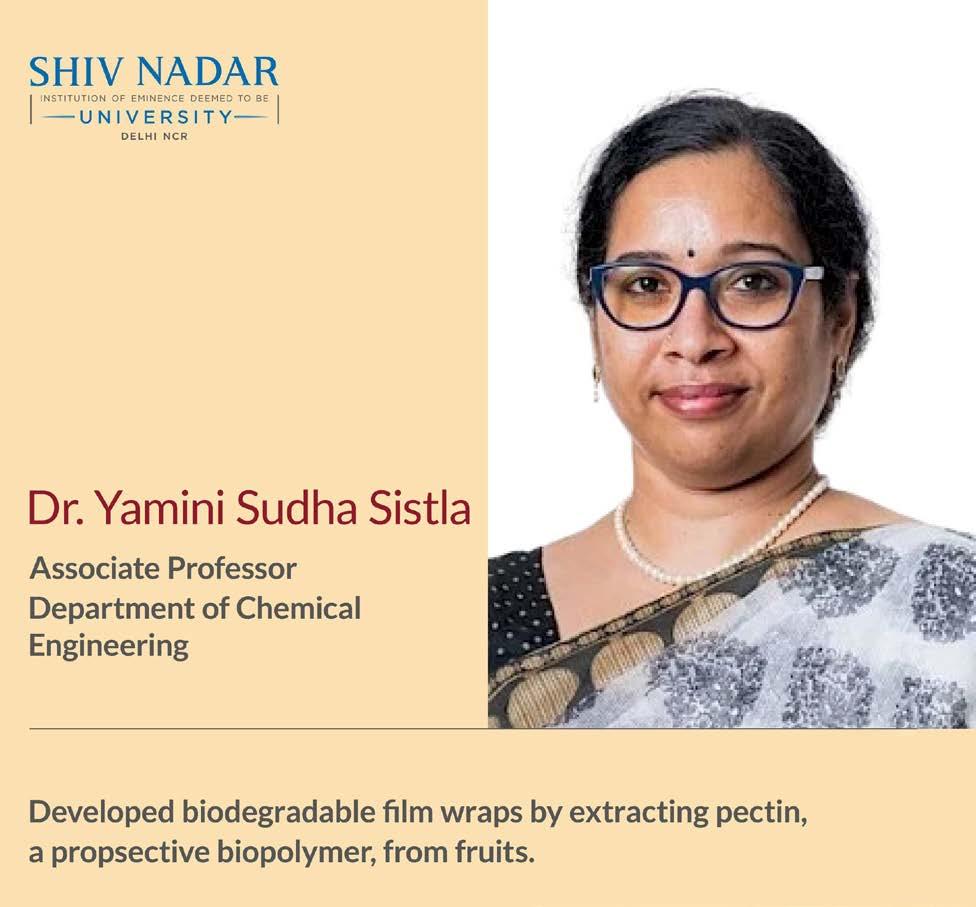

properties compared to pure pectin films. Dr. Sudha’s research is linked to SDG 3 (good health and wellbeing), SDG 11 (sustainable cities and communities), SDG 12 (responsible consumption and production), and SDG 13, 14, and 15 (climate action, life below water, and life on land).
Ecohydrological and hydrogeological dynamics of groundwater springs in
Eastern Himalaya, India
Groundwater springs are critical to achieving Sustainable Development Goals (SDG 6, access to clean water) in the Himalaya and remain highly vulnerable to climate change and land-use and land-cover change. In a first from Eastern Himalaya, the research analysed the relative controls of land-use, precipitation, soil properties, and hydrogeology on the diel and seasonal variability in three representative springs using high-frequency discharge monitoring. The study provides an integrated analytical framework for understanding Himalayan springs, which are critical for achieving SDG 6 (access to clean water) and a baseline for developing appropriate springshed models for effective management of freshwater ecosystems (SDG 15) against future climate change impacts (SDG 13), as well as informing the water security assessment in the Himalaya.
Kumar, Manish, Sumit Sen, Himanshu Kulkarni, Shrinivas Badiger, Girish R. Varma, and Jagdish Krishnaswamy. “Ecohydrological and hydrogeological dynamics of groundwater springs in Eastern Himalaya, India.” Groundwater for Sustainable Development 27 (2024): 101311.
Geo-information for Disaster Monitoring and Management
This publication provides insight into advancing remote sensing techniques dealing with floods, droughts, landslides, earthquakes, permafrostrelated hazards, glacial lake outburst floods, forest fires, droughts, tropical cyclones, climate resilience, and COVID-19. It incorporates the latest technologies and techniques to illustrate disaster monitoring for acquiring information and disseminating technological results and outcomes for the betterment of society. The publication would be of immense importance for earth scientists, policymakers, and professionals in disaster risk reduction.
Pandey, P.C., Kumar, R., Pandey, M., Giuliani, G., Srivastava, P.K., and Sharma, RK. (2024). Geo-information for Disaster Monitoring and Management. Springer. DOI: https://doi. org/10.1007/978-3-031-51053-3 ISBN978-3-03151052-6 ISBN978-3-031-51053-3(eBook)
Balancing greenwashing risks and forest carbon sequestration benefits: A simulation model linking formal and voluntary carbon markets
Voluntary carbon markets (VCMs) offer energyintensive firms a cost-effective way to reduce carbon mitigation expenses by promoting forest conservation. However, concerns about greenwashing may deter firms from using these options, which are susceptible to illegal forest harvesting. This study examines whether firms purchasing carbon credits from forestrybased communities can help strengthen forest conservation, mitigate project risks, improve environmental outcomes, and reduce abatement costs.
Ranjan, Ram. “Balancing greenwashing risks and forest carbon sequestration benefits: A simulation model linking formal and voluntary carbon markets.” Forest Policy and Economics 168 (2024): 103317.
CONVERSATIONS ON CAMPUS
International Conference on Sustainable Nanomaterials
Integration & Organization for Energy and Environment (iSNIOE2-2024)
Shiv Nadar University, in partnership with the University of New South Wales, Sydney, Australia, and KTH Royal Institute of Technology, Sweden, organized the International Conference on Sustainable Nanomaterials Integration & Organization for Energy and Environment (iSNIOE2-2024). With over 250 participants from India and abroad, this four-day conference united researchers and practitioners from academia, industry, and research laboratories worldwide, facilitating the dissemination of knowledge in sustainable nanomaterials and their innovative applications in renewable energy and environmental conservation.
The conference showcased 183 presentations, comprising 11 Plenary Speakers, 20 keynote speakers, 47 invited speakers, 46 oral presentations, 59 poster presentations, and over 60 speakers and researchers from various parts of the world.

MAGSOS Conference on Modern Aspects of Green and Sustainable Organic Synthesis
The Department of Chemistry, School of Natural Sciences, Shiv Nadar University, in collaboration with HEIA-FR, Chemistry Department, Switzerland, organized MAGSOS, a conference on Modern Aspects of Green and Sustainable Organic Synthesis, at the Shiv Nadar University campus on November 26 - 29, 2024.


Discussion to explore research partnerships
between the University and India’s biggest commercial oil corporation
Shiv Nadar University Delhi NCR on Wednesday hosted Mr. ALOK SHARMA, Director, Research and Development Centre, Indian Oil Corp Limited (IOCL), along with his leadership team.
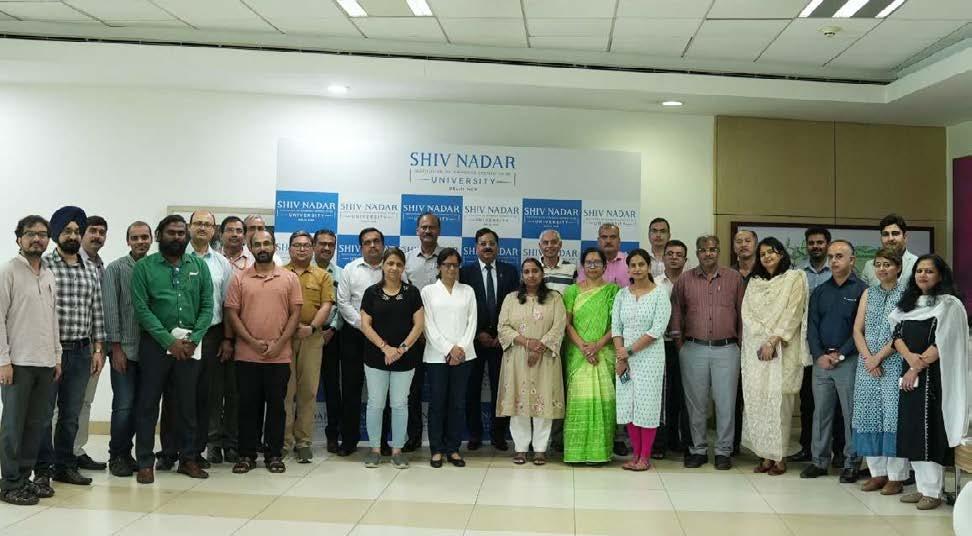
Discussing ways to explore research partnerships between the university and India’s biggest commercial oil corporation in nanotechnology, renewable energy, sustainable energy technologies, energy storage and conversion, and materials processing, Mr. Sharma highlighted that, despite being a young institution, the research done by Shiv Nadar University is commendable. There are many opportunities for collaboration in research and industry-oriented projects that can drive innovation, boost economic growth, and contribute to societal progress. Such collaborations can help convert research into marketable products and services with the support of the industry.
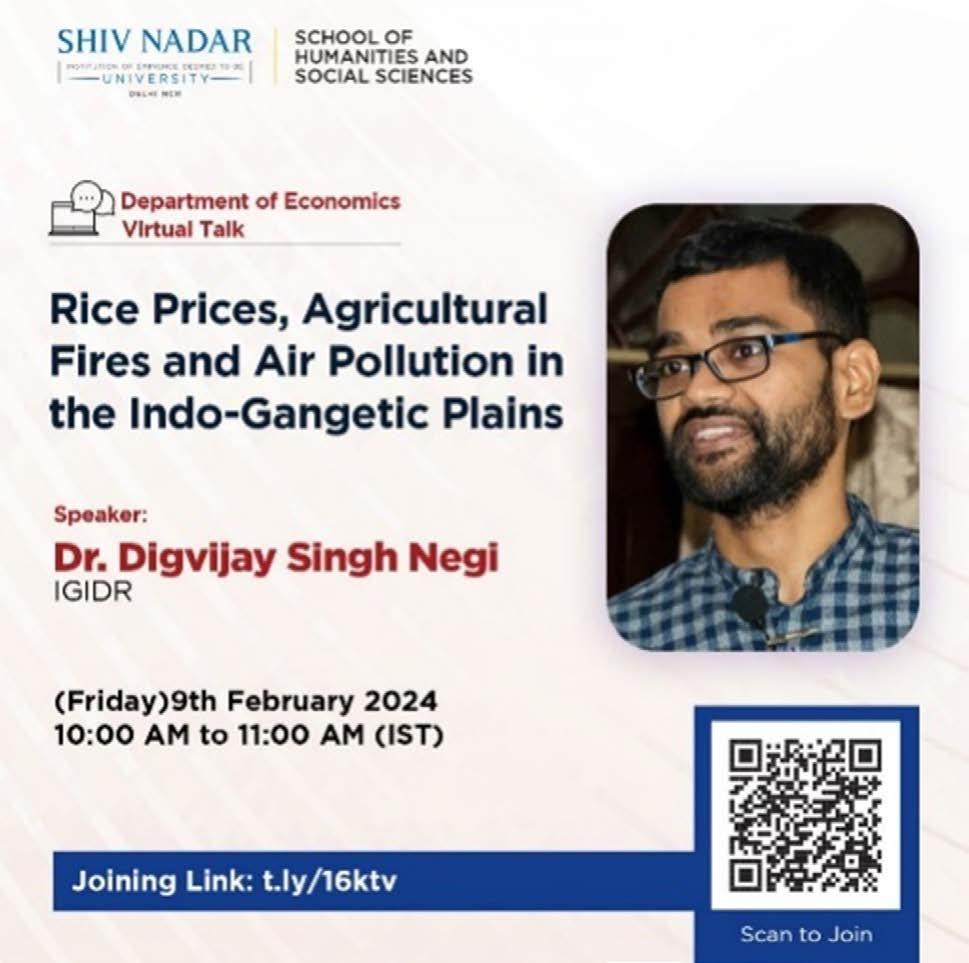
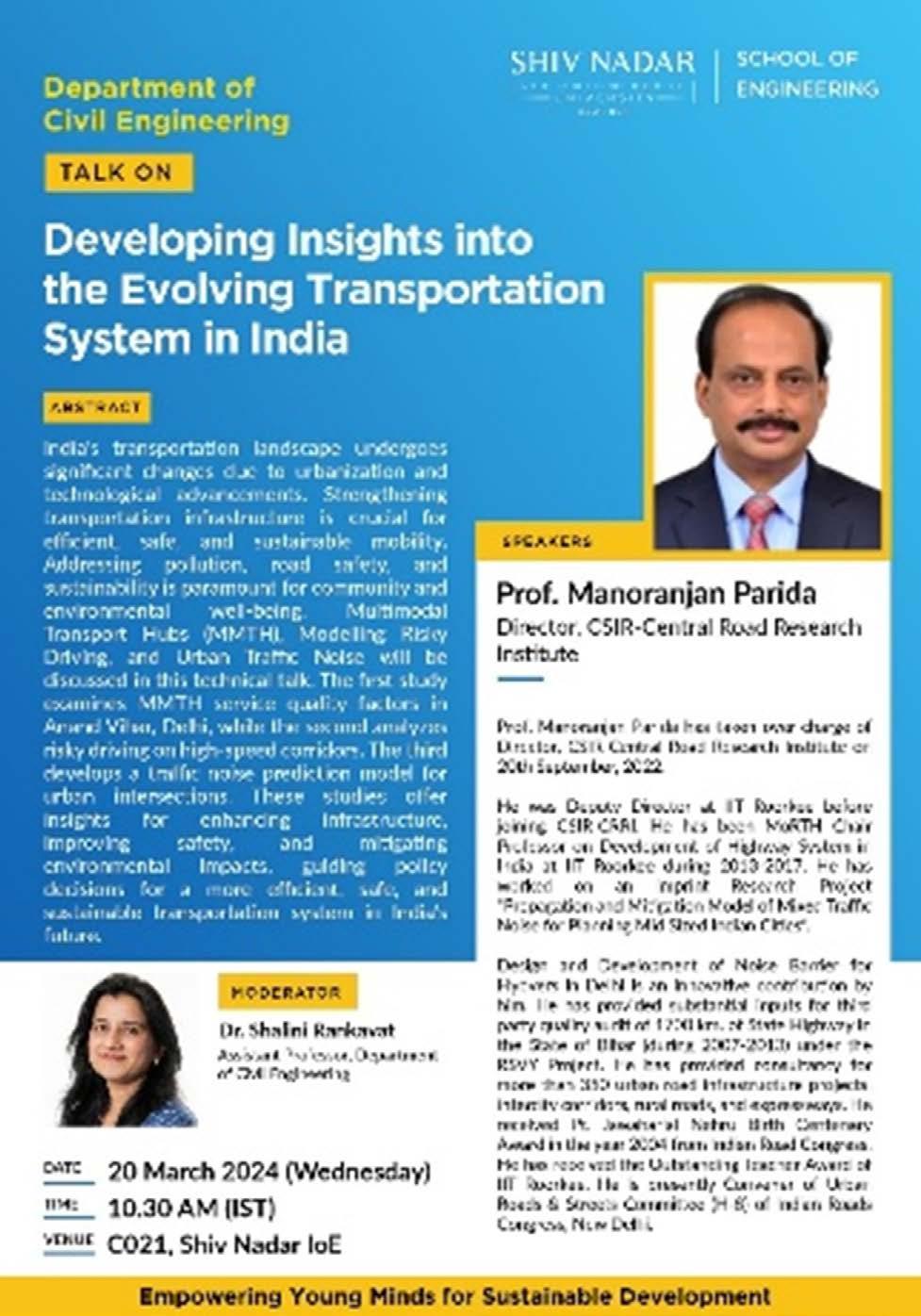
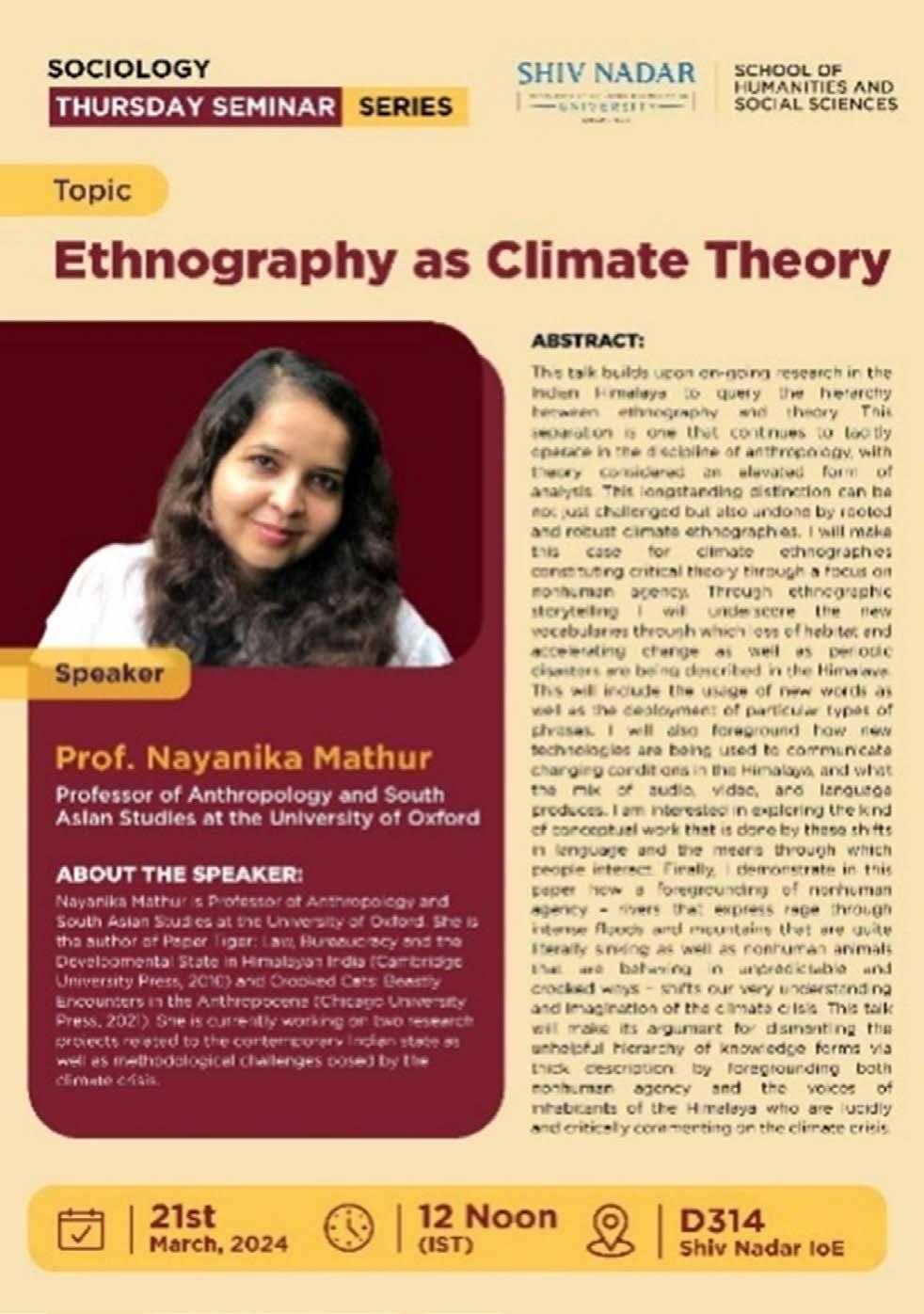
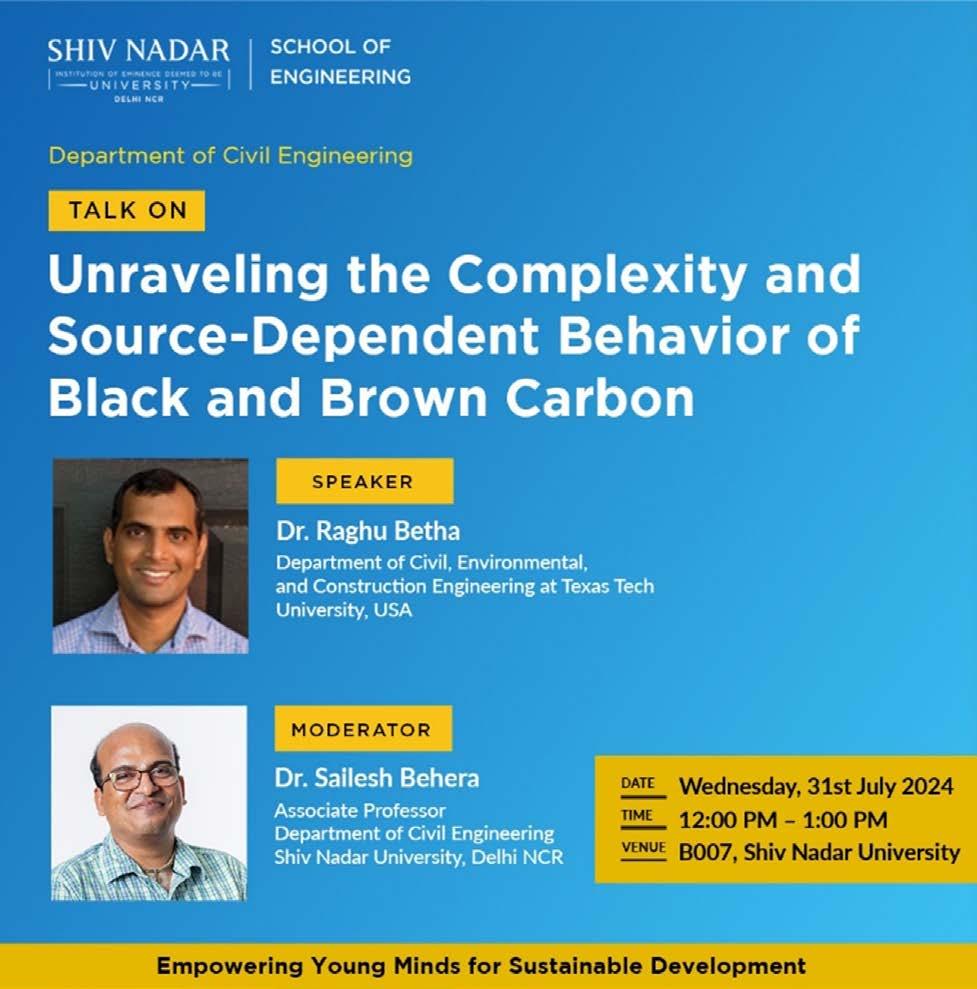
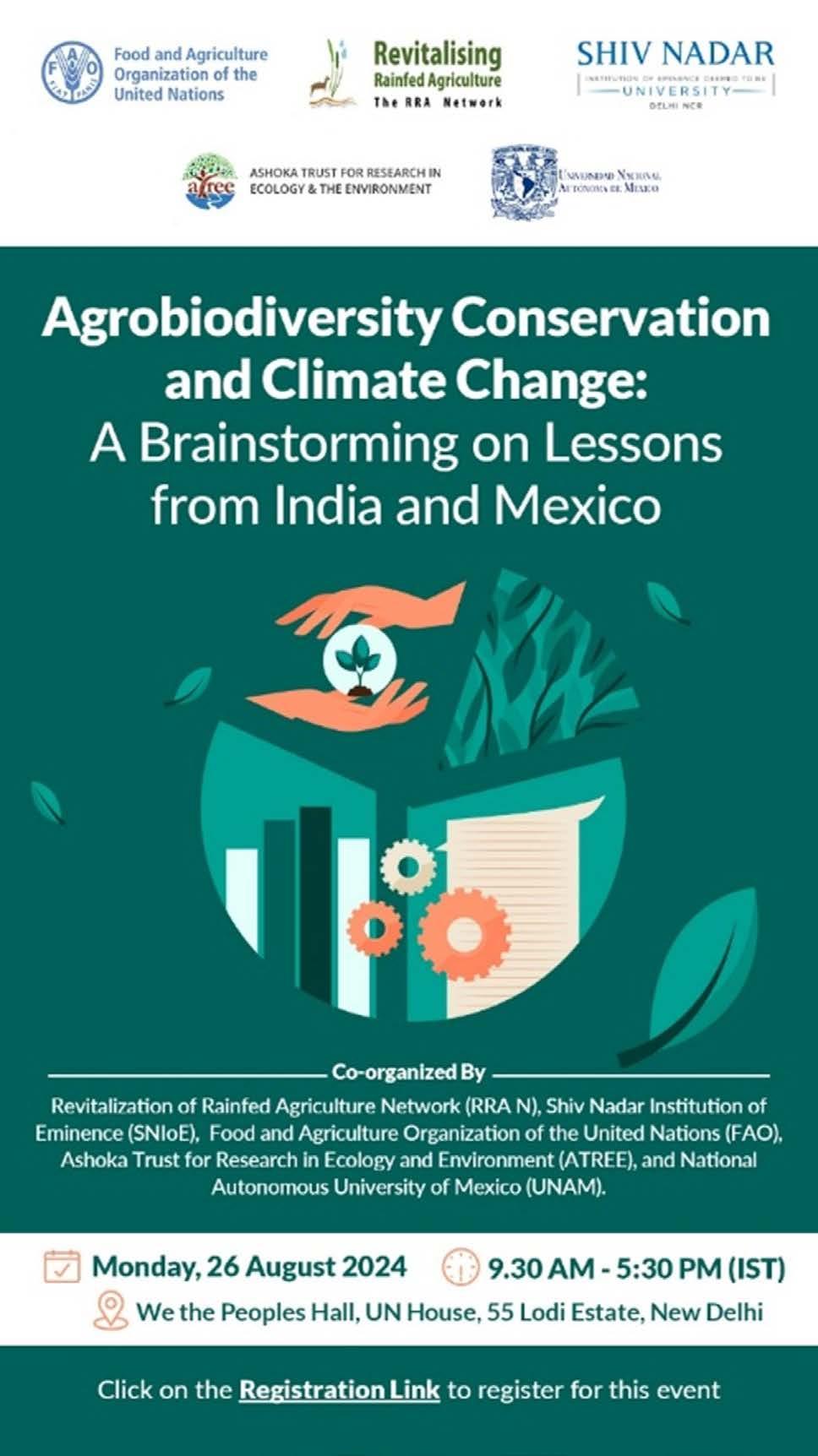
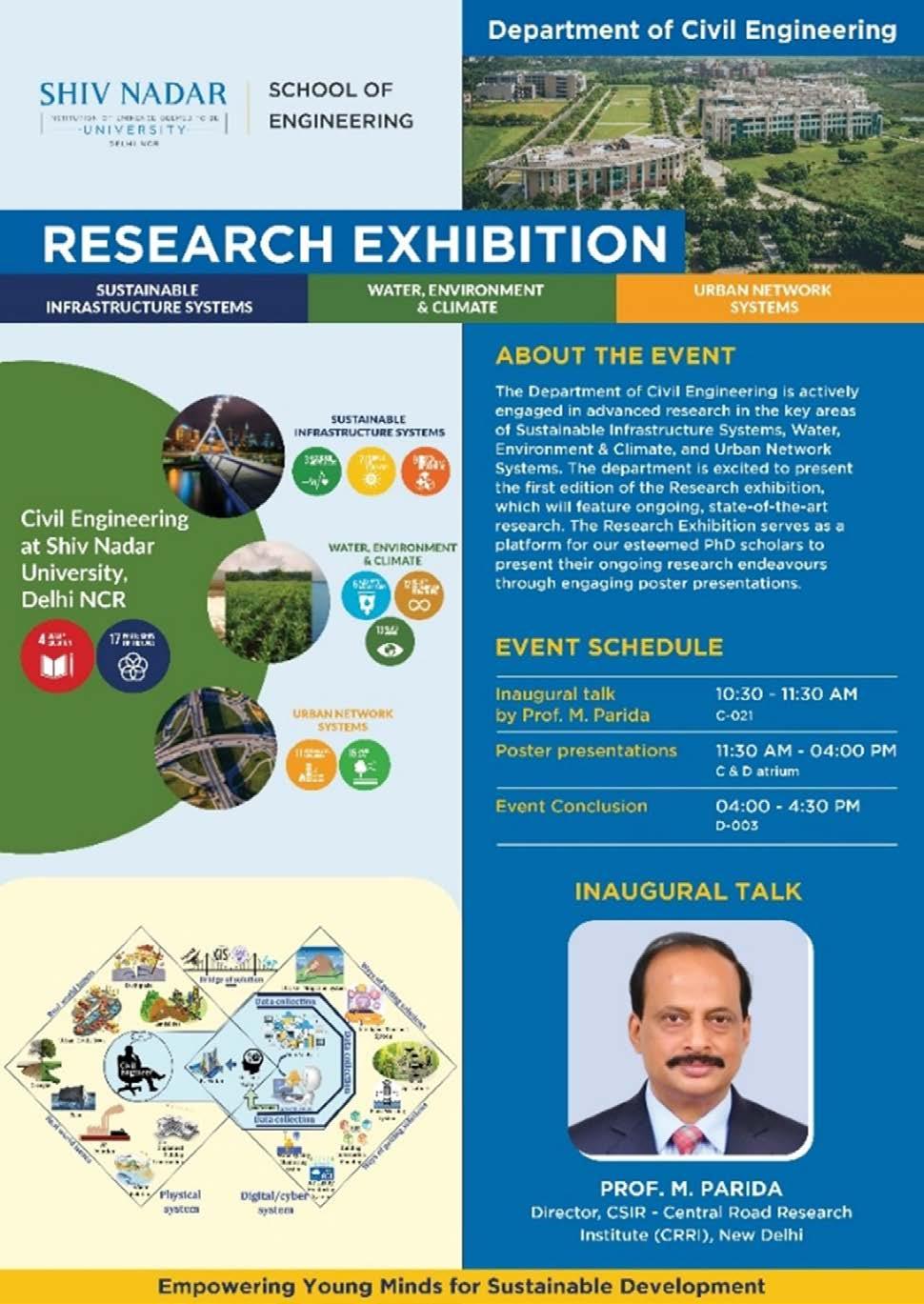
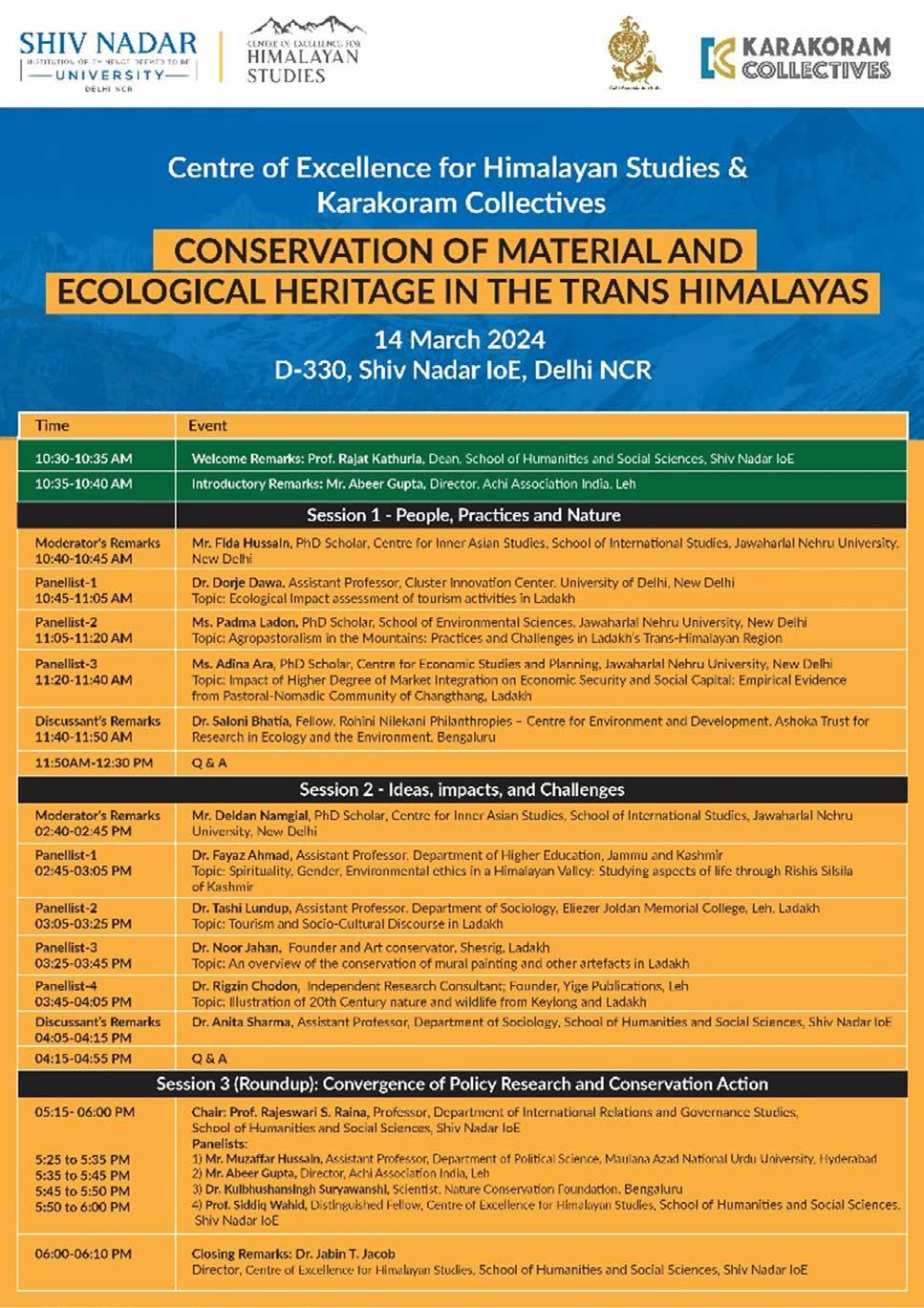

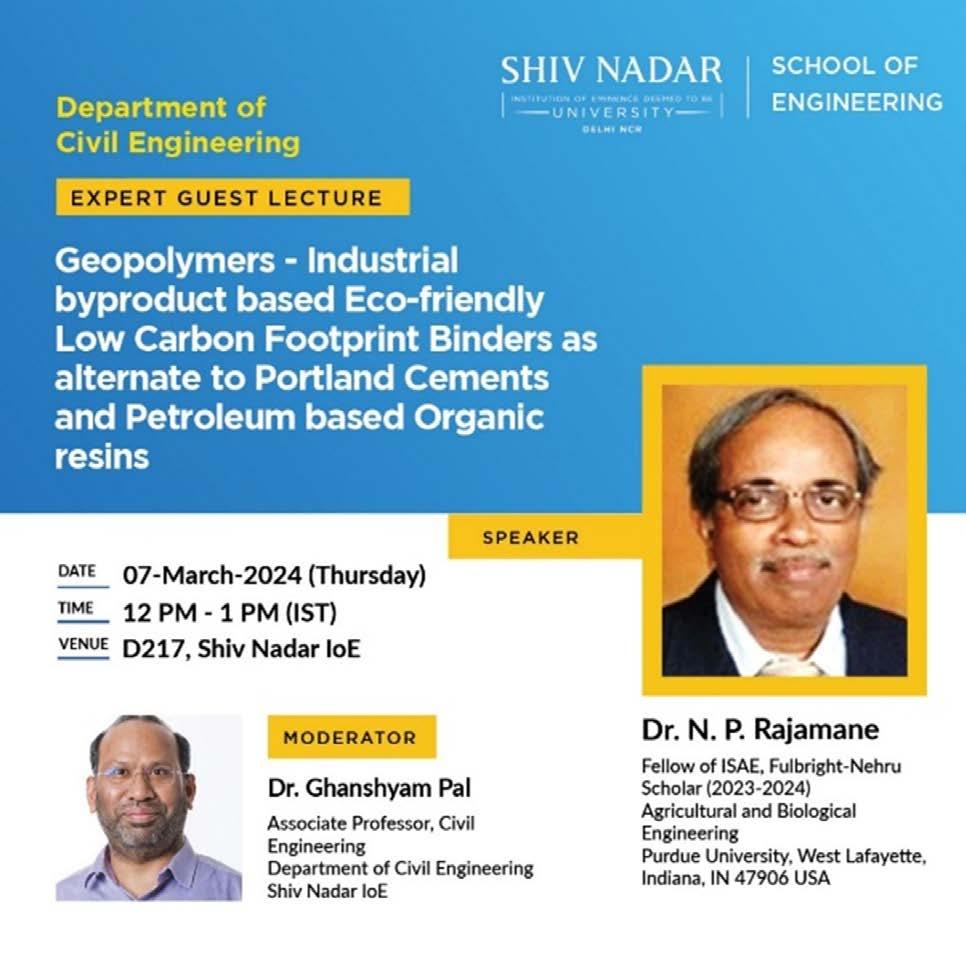
UNIVERSITY OPERATIONS
At Shiv Nadar University, we have taken multiple initiatives following a structured sustainability framework with specific targets and timelines, advancing several sustainable development goals.
Green Building Design and Operations
All buildings on campus comply with the National Building Code, certified by the Indian Green Building Council (IGBC) or Leadership in Energy and Environmental Design (LEED).
• Several buildings are LEED Gold certified and incorporate green building principles such as natural lighting, efficient insulation, sustainable materials, and low-flow plumbing fixtures, thus making them water and energy-efficient.
• Besides achieving EHS certification, the university has a policy that promotes environmentally friendly and low-emission practices in water, energy, waste, habitat protection, etc. We have also been awarded ISO 14001:2015 and ISO 45001:2018 accreditation without any non-conformance or observation.
Renewable Energy on Campus
We have undertaken an initiative to transition to clean energy sources on campus.
- A 1.6 MW solar power plant installed and
commissioned on campus covers as much as 26 percent of the campus’s needs. The goal is to go to 30 percent and beyond.

Renewable Energy Generation
– 270 % rise between 2019-20 and 2023-24
Enhance Energy Efficiency
As a part of our Energy Consumption Analysis and Conservation Plan, we review our energy use continually to identify opportunities for improvement. To document the energy consumption of each building, electricity meters are installed in every building, and a complete analysis of energy consumption is reported every month in the “Energy Performance Index Report.” This helps to check waste continuously.
Many energy-efficient appliances have been incorporated, such as:
• Energy Optimization Monitors in our LEED and IGBC- Gold certified building with integrated sensors, IoT devices, and automation systems for optimized energy use and reduced overall environmental impact
• Effective electric vehicle infrastructure on campus to transition 50% of the car fleet to electric vehicles, increase mobility on campus, and reduce carbon footprint and dependency on fossil fuels.
• Modular sewage treatment plant technology is installed on campus and has a capacity of 734 KLD. The STP currently treats 550 KLD of water from the entire campus, including campus housing.
• Monitoring platforms installed to track energy usage, waste generation, water consumption, and other sustainability metrics to enable informed decisions for continuous improvement
• 1.6 MW solar panels installed on campus across academic and residential blocks to transition from complete captive power and generate clean, sustainable energy on campus
• Energy-saving policy embraced, replacing 11 KV grid power with a 33 KV grid power supply and removing the need to run standby power through diesel generators.

Green House Gas Emissions: 13.94% reduction between 2023-24 and 2022-23
Alternative Mode of transport to achieve sustainable transportation
Shiv Nadar University is a residential campus for all students and many faculty and staff members. For those who stay outside the campus, a well-planned transport system is in place, and employees are encouraged to be sensitive to their use and optimize their air and road travel. For weekly needs, planned shuttles are provided. To transition to clean power and reduce dependence on fossil fuels, we plan to transition 50% of the car fleet to electric vehicles. The university currently has 60% CNG, 30% petrol, and 10% diesel cars. The plan is that any new inventory added to this would be an electric vehicle.
On campus, we use sustainable transportation options such as walking, biking, carpooling, and public transit. We have a fleet of E-buses and Golf carts with over 150 seating capacity. This, in turn, has helped increase mobility on a large campus like ours and is also a step towards reducing the carbon footprint and dependency on fossil fuels.
Geo-tagging of the Campus’s rich plant life is in progress.
In a drive to geo-tag trees on campus, we have carried out an inventory of and affixed QR codes on 13500 trees with 44 individual species present within the boundary of Shiv Nadar University using the census method. More than 20 primary and secondary attributes have been recorded for each of these trees, including Latitude and Longitude, Local Name, Girth, Height, Condition, and Canopy Diameter, to name a few. The trees have been assigned a specific QR code, which, when scanned, gives detailed information about the tree.
The university has beautifully landscaped gardens, tree avenues, and sprawling grassy areas developed and planned by a horticulturist, thus increasing the tree cover and overall greenery on campus.
With a green cover of 35.5 hectares, we have created a sequestration potential of 5412.8 MTCO2e. Please highlight this.
To date, we have the following ground cover:
1,70,127
Ground Covers 3,03,624 4 Grass 3,44,123 sqm.
Reduce waste and Recycle
We have implemented comprehensive waste reduction and recycling programs to encourage a culture of rethinking consumption patterns on campus. The following are some examples,
• The university has a comprehensive and documented food waste tracking system to measure and monitor food waste at each level, i.e., production, handling, storage, processing, and distribution. Taking efficient measures and maintaining a daily food waste log, we reported a considerable decrease in food waste per person in 2024. This also gives the dining hall vendors a minimum guarantee to keep a check on production, and food waste is used for composting on campus.
• The campus has a restrictive use of plastic. This behaviour is encouraged on campus through communiques and posters for responsible consumption and conservation. Since 2019, plastic waste has been monitored, tracked, and disposed of through green disposal methods. To date, we have achieved a 47% decrease in plastic waste disposal. Wastepaper collection and disposal happen through government-certified recyclers, which provide recycled paper, paper, and other stationery. Besides, using recycling bins across campus, composting organic waste, and reducing single-use plastics. We have special contracts and systems for safely disposing of hazardous and medical waste.
• Free Store is a student-led initiative on campus to promote recycling. The university community has enthusiastically responded to converting pre-loved clothes into re-loved garments for someone else.
Educate, Engage, and Encourage
• We have set the culture of holding a sustainable University Convocation, which includes a full spectrum of associated digital experiences, significantly reducing the volume of printed convocation materials.

• The university has its own independent program towards energy conservation, renewable energy, and efficiency through reduced consumption in Scope 1, 2, and 3. Besides, we are also developing a road map towards expediting steps to achieve net-zero and become a smart campus in every sense.
• We offer a year-long series of short programs and masterclasses for school students.
Community Initiative - Dadri Development Project
Shiv Nadar University is located in a region called Dadri in Uttar Pradesh. Dadri is a rapidly urbanizing rural region with high socio-economic inequality and low SDG outcomes. The university is deeply committed to generating a positive impact on the area and, accordingly, has assumed a central role in the Dadri Development Project, a transformative initiative convened by the Shiv Nadar Foundation
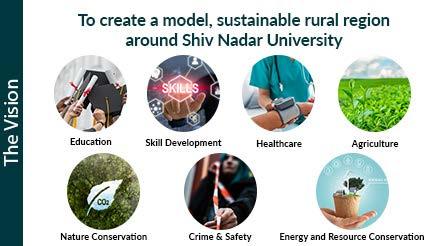
(SNF), a non-governmental organization. The project aims to create a “model sustainable rural community around Shiv Nadar University.” This commitment is shared by the university leadership, staff, and students and is instilled in the core of the niversity’s academic mission.
The projects include well-considered, need-based interventions with multi-stakeholder engagement, implemented in phases, supported by thorough evidence, and subjected to rigorous monitoring and evaluation. These projects focus on education, health care, skill development for employability, social safety, nature conservation, agriculture, and imparting knowledge on effective use of resources in our daily life.
PARTNERSHIPS
Partnership with Industry
Dr. Sanjeev Yadav, Associate Professor, Department of Chemical Engineering, and his research group work with Varhad Capitals Pvt Ltd, a Nagpurbased industry. The industry is supporting work on biomass conversion into bioenergy and has signed a Memorandum of Understanding for three years. Varhad is leading the initiatives in carbon dioxide removal (CDR) and soil enhancement. They cultivated a vast network of farmers through 165 farmer cooperatives in India. Using carbon-rich materials like cotton and pigeon pea stalks, they achieved a Carbon Dioxide Removal rate of 2.4 tons of CO2 per ton of biochar.
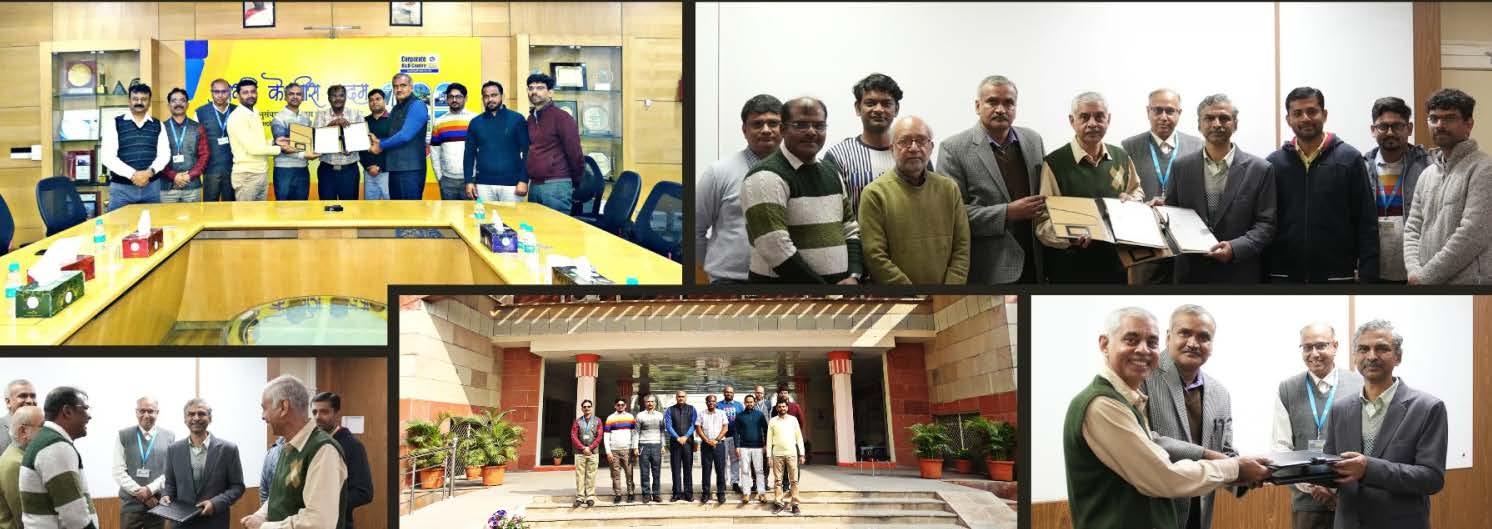
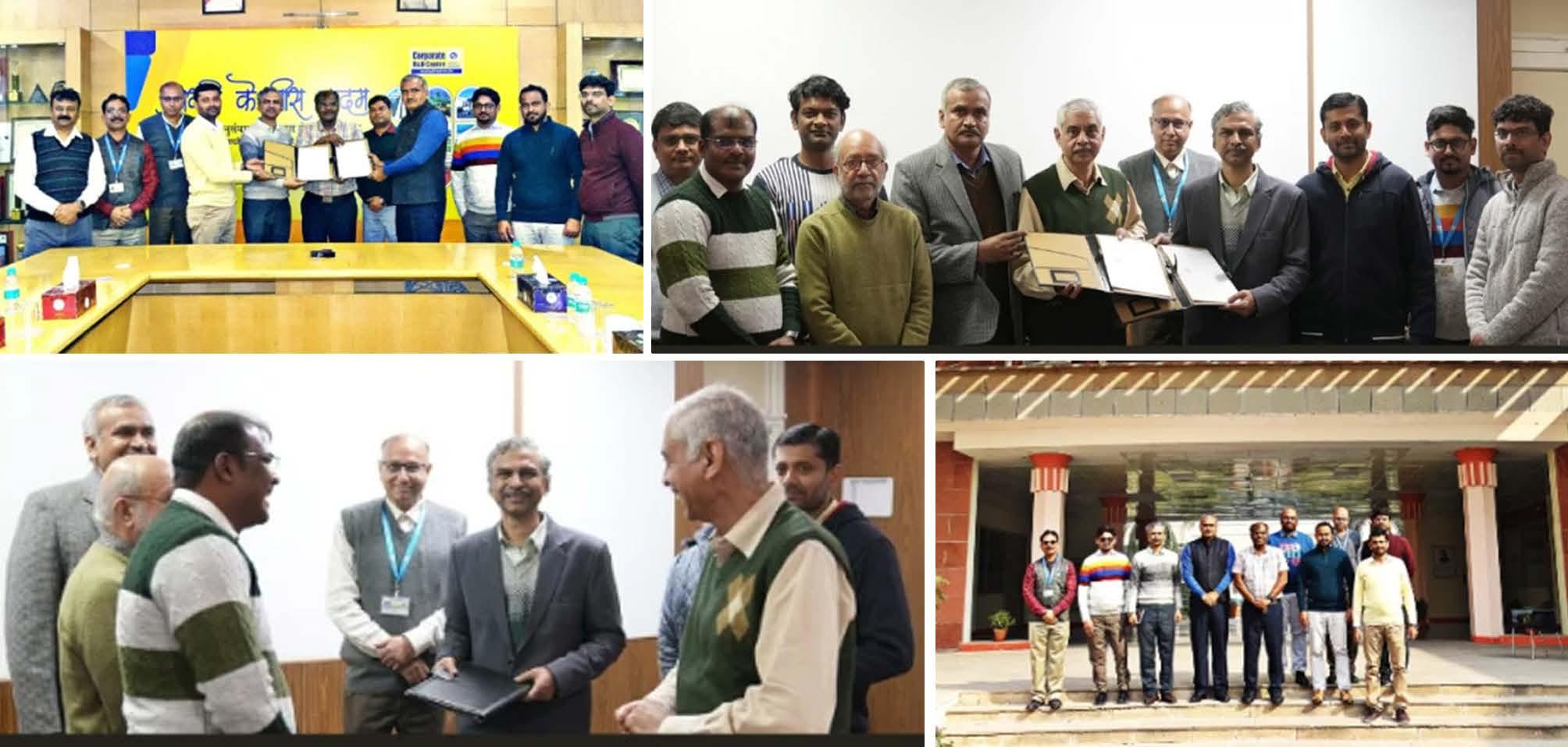
Dr. Yadav and his research group have also designed a portable pyrolyzer capable of using various kinds of waste biomass, especially agri-residues, to produce biochar. This has already yielded large biochar production across many states with the help of the industry partner. Biochar production is a sustainable and environmentally responsible process that manages agricultural waste efficiently.
Industry-Academia partnership to drive sustainable technological advancements
Shiv Nadar University, in partnership with Bharat Petroleum’s Corporate Research & Development Centre (CRDC), is a significant stride towards advancing sustainable chemical processing technologies. By focusing on process intensification for highly exothermic reactions, the project aims to develop novel reactor designs that enhance energy efficiency and reduce waste. This initiative aligns with several critical sustainable development goals, including Goal 9: Industry, Innovation, and Infrastructure, by fostering sustainable industrial innovation and infrastructure development through advanced reactor designs. Goal 12: Responsible Consumption and Production – By emphasizing efficient heat management and reducing the environmental impact of chemical processes. Goal 13: Climate Action - By enhancing energy efficiency and minimizing waste, our collaboration contributes to efforts to mitigate climate change impacts. This partnership exemplifies how industry-academia collaborations can drive sustainable technological advancements, aligning with India’s commitment to the United Nations Sustainable Development
Goals (SDGs). This partnership project is going to have a positive impact on industry standards and environmental sustainability.
Solvated Ionic Liquid-based sacrificial SulfonAmide assisted Na-ion Capacitor (SILSACap)
Dr. Binson Babu, Assistant Professor, Department of Physics, has received a grant from the Science and Engineering Research Board (SRG). This grant of INR 28,03,785.00 supports the project SILSACap for two years.
The “SILSACap” project aims to develop a safe, highpower, and energy Sodium ion Capacitor (NIC) with a target of cycling stability of > 15,000 cycles with > 90% capacity retention at the practical level through a holistic approach with systematic innovations of the electrode, electrolytes, and evaluation of the storage interfaces.
The successful development of the ‘SILSACap’ concept will contribute to the advancement of sustainable high-power/energy Na-storage devices, which is an essential requirement of the future post-lithium era. Its accomplishment will likely have a major impact on fundamental sciences in general and strengthen interdisciplinary research activities. Moreover, the success of the project has an economic and technological impact by creating novel storage products, services, and business processes. It has also had a social impact by contributing longterm to India’s decarbonization policy (e.g., COP27 climate summit) and aligning with the Sustainable Development Goals (SDGs).


Shiv Nadar Institution of Eminence is fully committed to the UN Sustainable Development Goals (SDGs). We have embraced a four-pronged strategy for SDGs through teaching, research, our core institutional practices, and partnerships.
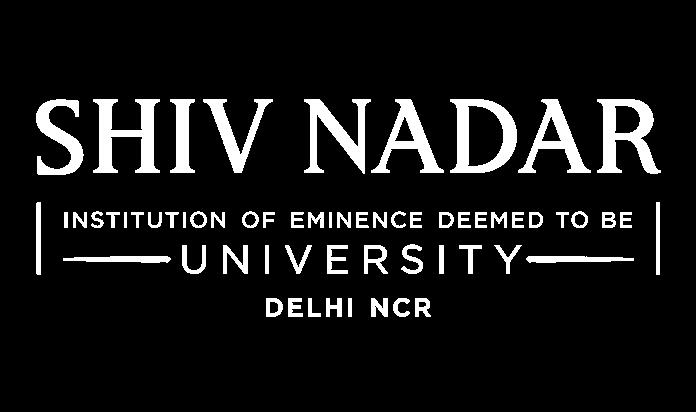
Deepa Hazrati Senior Manager, Office of the Vice-Chancellor deepa.hazrati@snu.edu.in
